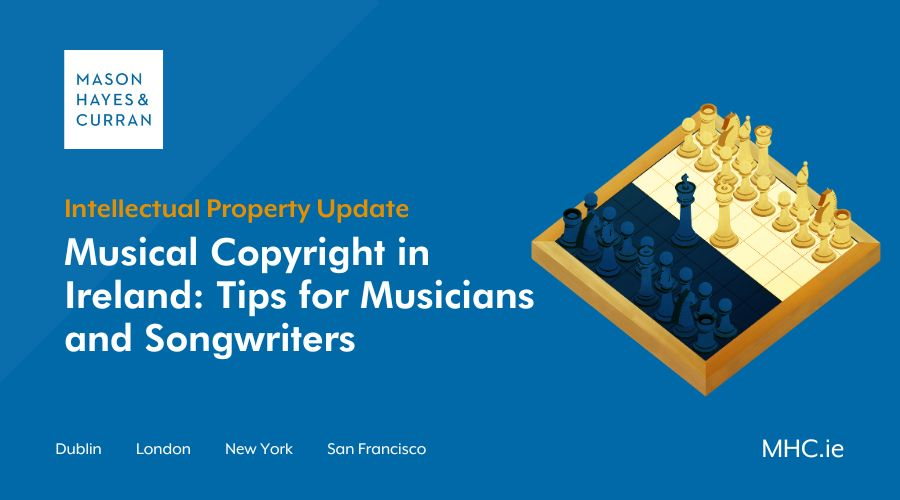Musical Copyright in Ireland: Tips for Musicians and Songwriters

In recent years, the number of musical copyright lawsuits, particularly against well-established pop stars has increased. Gerard Kelly, Head of Intellectual Property, reviews the impact of some of these decisions and provides some tips for musicians to avoid claims of copyright infringement.
The law on music copyright is far from certain. A Los Angeles court in 2015, found that the composers of the song, “Blurred Lines”, had illegally copied Marvin Gaye’s 1977 hit “Got to Give It Up”. As a result the court ordered that the Gaye family be paid $5.3 million, in addition to being given a half share of the song’s future publishing royalties. This was the first time copyright in a musical style had been recognised. The decision was ultimately upheld in the Court of Appeals in 2018 resulting in a fear that the floodgates on claims like these would be opened, particularly in the world of pop music.
The rise in claims
Arising out of the Blurred Lines case, a number of further claims were threatened or issued. For example in 2015, Sam Smith settled a case with Tom Petty over the similarity between the chorus in Petty’s “I Won’t Back Down” and Smith’s song “Stay with Me”. In 2021 Olivia Rodrigo, who may have wanted to avoid such proceedings, offered the band Paramore a writing credit and a share of the profits from her song “Good 4 You,” whose hook sounds extremely similar to the pre-chorus of Paramore’s “Misery Business.”
More recently, Ed Sheeran has become the target of multiple copyright infringement claims. In 2017, Sheeran settled an infringement claim brought by the writers of “Amazing,” a song performed by a previous winner of the “X Factor”, who argued that Sheeran’s 2014 hit “Photograph” infringed on their song. Sheeran’s highly popular song “Shape of You,” was the subject of multiple disputes. One such dispute was with the songwriters of TLC’s hit “No Scrubs” and was amicably resolved. Sheeran, then went and initiated a case in the U.K., against Sami Chokri, a British songwriter and grime artist, in response to assertions that Sheeran’s “Shape of You” had stolen the chorus from his 2015 song “Oh Why.” Sheeran won this case with Chokri being ordered to pay his costs.
Thinking Out Loud
Sheeran has openly acknowledged that most pop songs, including his own, comprise of three or four chord progressions and are very similar in their format. In a YouTube video recorded at a concert in Zurich in November 2014, Sheeran was seen transitioning easily between his song “Thinking Out Loud” to another Marvin Gaye song “Let’s Get it On”. This footage was submitted as evidence in a more recent US case involving these two songs. The case was filed in New York and claimed that “the melodic, harmonic and rhythmic compositions of ‘Thinking Out Loud’ are substantially and/or strikingly similar to ‘Let’s Get It On’”.
Like in the Blurred Lines case, the case against Sheeran focused more on compositional features or “the groove” of the song rather than comparing obvious melodic or lyrical similarities. Fortunately for Sheeran, who had stated that if he lost, he would be retiring from music altogether, the jury found in his favour and decided that he and his co-writer, Amy Wadge had independently created “Thinking out Loud” and had not infringed on Marvin Gaye’s “Let’s Get it On”.
Of note in this case was that due to the fact that “Let’s Get it On” was a pre-1978 recording, it’s legal status is dealt with under the 1909 Copyright Act. Under that American piece of legislation, in order for a musical work to obtain copyright registration, a written record of the composition had to be submitted to the US Copyright Office rather than a recording. Because of this, the jury in the case were not permitted to listen to any pre-1978 recording. As such, they were comparing Sheeran’s recording of “Thinking Out Loud” with the sheet music and a computer generated recording of “Let’s Get it On”, arguably not taking into account some of the essential features of the song. This begs the question of whether the case would have been decided differently if the jury had been permitted to take into account the pre-1978 recording when reaching their verdict.
While the above decisions were decided in US and UK courts, the increasing number of copyright claims against songwriters in recent years begs the question of what musicians need to be conscious of in order to avoid claims for copyright infringement.
Copyright in Ireland
The law on copyright in Ireland is primarily dealt with under the Copyright and Related Rights Act 2000 (as amended) (2000 Act). In addition, in Phonographic Performance Ireland Limited v. Cody, the Supreme Court stated that the right to be identified with a creative work, and to enjoy protection whereby others are not allowed to copy it without permission was protected by the Constitution. Section 17(1) of the 2000 Act states that “copyright is a property right whereby, subject to this Act, the owner of the copyright in any work may undertake or authorise other persons in relation to that work to undertake certain acts in the State, being acts which are designated by this Act as acts restricted by copyright in a work of that description”. Further to this, under section 17(2) original musical works are specifically protected by copyright. It should be noted that copyright does not extend to ideas. As such, the work must be recorded in writing or another tangible form for copyright to arise, further details of which can be found in section 18(1) of the 2000 Act. In addition and in contrast to US law, there is no requirement to formally register copyright under Irish law. The right arises automatically upon creation.
Originality
As mentioned above, for a song to be protected by copyright in Ireland, it must be original. There is no statutory definition of an original work. That being said, at EU level the test for originality requires that the work be an expression of the author’s own intellectual creation and that it be identifiable with sufficient precision and objectivity.
Infringement by copying
Under section 37 of the 2000 Act, copying a work without permission amounts to infringement. For infringement to arise, either the work as a whole or a substantial part of the work must be copied. For music, when looking at what is significantly similar, a court will take into account elements such as:
- Signature phrases
- Hooks
- Bass lines
- Keyboard chords
- Harmonies, and
- Vocal melodies
It should be noted that generic unoriginal elements are unlikely to be found to have acquired copyright protection.
To sustain a claim to infringement by way of copying, there must be:
- sufficient objective similarity as between the works, and
- there must be evidence that the copyright work is the source from which the infringing copy is derived
There does not necessarily need to be “note for note” copying in order to succeed. In addition, it is also possible that copying may be found to be subconscious.
Top tips for musicians and songwriters
While the cases referred to above apply US and UK law coupled with the fact that a major music copyright dispute has yet to be heard before an Irish court, there are a number of general tips that are worth considering by musicians working in Ireland:
- The best way to avoid copyright infringement is to create your own original music. This means composing your own melodies, writing your own lyrics, and producing your own tracks. By doing so, you minimise the risk of unintentionally copying someone else's work.
- Be wary of the risk of subconscious copying. While it's normal to be inspired by other musicians, be cautious not to inadvertently copy their work. Pay attention to the music you listen to and regularly analyse your own compositions to ensure they don't infringe on existing copyrights. Develop your unique style and strive for originality.
- Upon creation of a piece of music, record it or write it out in manuscript form and lodge it in a safe place such as with a solicitor. Alternatively, post it to yourself by registered post. Of course there may be metadata for electronic files which shows the date of creation but such evidence will need to be robust. None of this is essential for copyright to subsist but if a dispute regarding ownership arises you will be in a position to prove that your music was in existence at a particular date, ie the date stamped on the registered mail envelope or the recorded date of receipt by the solicitor.
- Ensure that any samples that are being used in your work are cleared and that you have the required permissions from the copyright owner to use them.
- If you want to release a cover version of someone else's song, you need to obtain the necessary permissions.
- Be inspired, but don’t copy. You can be inspired by other musicians but remember that the work must be your own intellectual creation.
For expert advice on successfully protecting your IP rights in 2023, contact a member of our Intellectual Property team.
The content of this article is provided for information purposes only and does not constitute legal or other advice.
Share this:

Gerard Kelly SC
Partner, Head of Intellectual Property Law, Co-Head of Dispute Resolution
+353 86 820 8066 gkelly@mhc.ie


